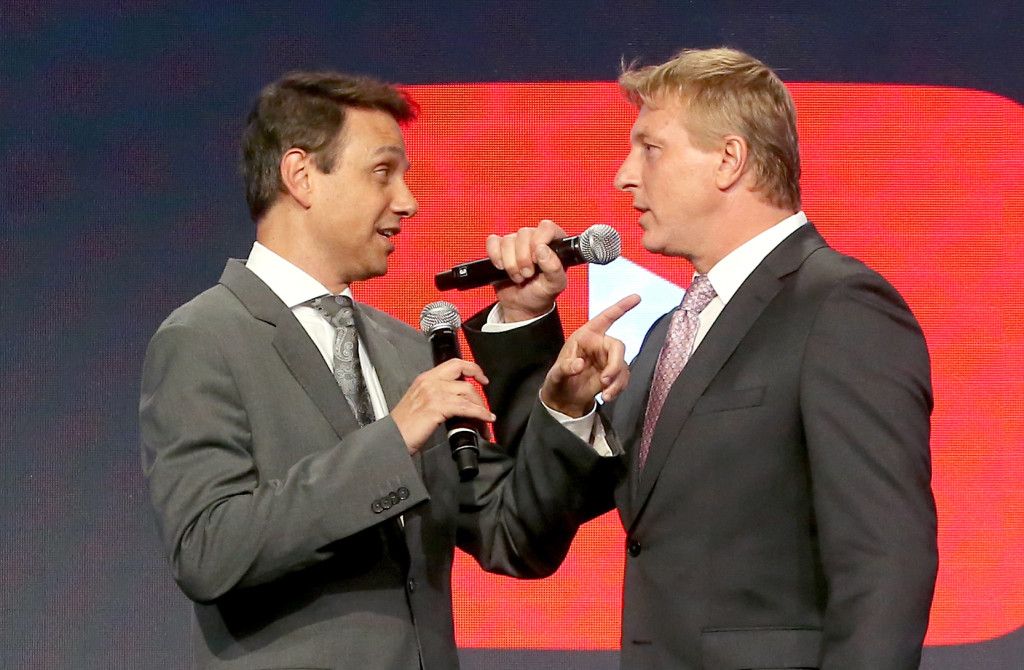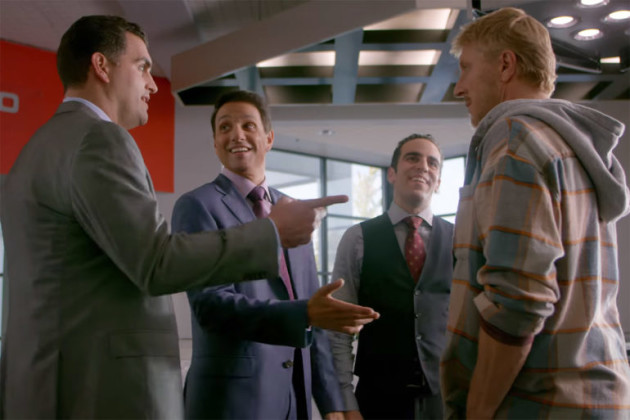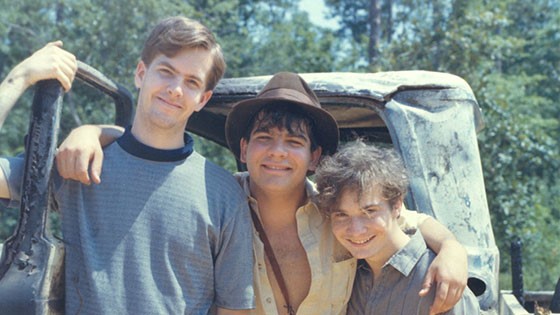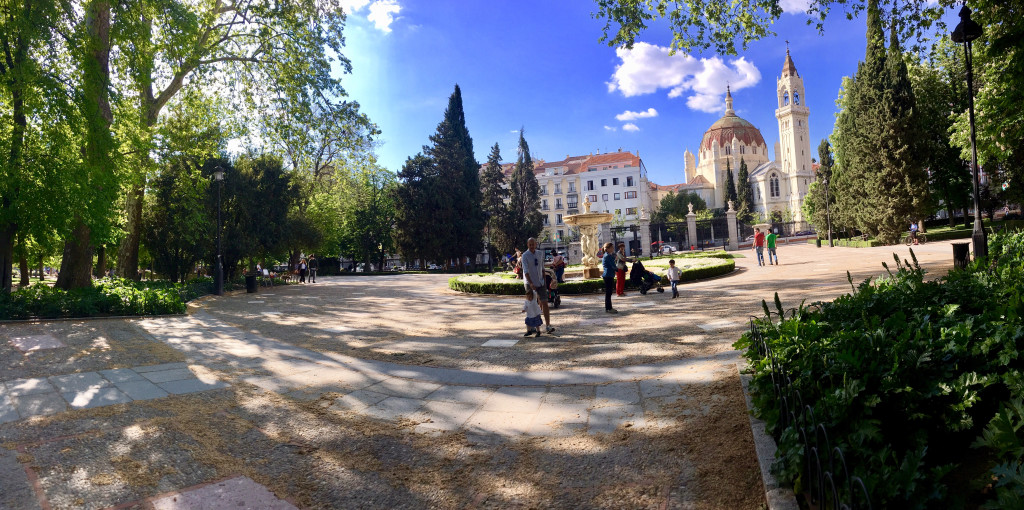With 25 million views (and counting!) for its premiere episode, Cobra Kai has single-handedly made Youtube Red a player in the streaming wars. As Hollywood is an unapologetic copycat league, it’s only a matter of time before we get more rebooted 80s franchises in TV form. But many, if not all of these reboots, will be bad. That’s because Hollywood execs rarely understand why stories work. The only things they understand are what they see on the surface (“Karate is big again!” “80s reboots work!”). Cobra Kai became an out-of-nowhere hit because of some sneaky clever conceptual and execution choices the average schmoe won’t pick up on. Luckily, you’re not the average schmoe. You read Scriptshadow. Which means you’re about to learn some slick screenwriting secrets that should serve you well on your next assignment.
A character on the bottom is more interesting than a character on top – The writers of Cobra Kai understood that if the main storyline came through Daniel LaRusso’s eyes, it would’ve been boring. Most writers would’ve constructed a show where Daniel prepped his daughter to become the next karate kid. That would’ve been dreadful. Instead, the creators saw that Johnny’s life had hit rock bottom, which meant there was a potential for him to rise up. That decision was the single biggest factor in making this show a hit.
Audiences will root for anybody at rock bottom who tries to dig their way out – There isn’t a more likable situation than a character who’s in the gutter but doesn’t give up. Why? Because most people aren’t where they want to be in life. They want more. So when they see someone below them change their circumstances by sheer force of will, they derive hope that they can achieve the same. This is why Johnny, who’s mostly a dick, is so easy to root for. He’s at the bottom but he’s not giving up. He’s determined to rebuild his life.
Never betray who your characters are. They will read false. – These days, TV characters speak as if they’ve been vetted by a studio’s legal team to make sure nobody on the planet is offended by anything they say. It’s become a boring part of television because it’s not real life. In real life, people say bad shit. So when Johnny calls fat kids fat. When he makes fun of a kid with a cleft lip. When he tells kids they’re losers who will never get laid, we feel like we’re finally seeing real life again. You have to stay true to your characters. The second you betray that, the suspension of disbelief is broken.
Use money to keep pressure on your protagonist – One of the oldest cliches in storytelling is lack of money. But it works because everyone can identify with unpaid bills, with scraping by, with trying to get to that next month. If your hero needs money to survive, it creates unresolved conflict within that forces them to be active. A constant tension for Johnny is all the overdue bills for his dojo’s rent and business expenses. We know that if he doesn’t find more students soon, he’ll go belly up. And it works like a charm! We never say, “Oh, that’s so cliche that he doesn’t have enough money.” We buy it because we can relate. This leads us perfectly into our next lesson…
There are two types of cliches, truthful and dishonest – When attempting to navigate cliches, remember that cliches work as long as they’re truthful. If you’re exploring them in an honest way, they’ll work. If you’re slapping them in there without exploring them, they will become dishonest. For example, the absent father is a cliche that’s been around as long as television. But if in each episode you’re trying to explore how the father-son relationship became that way and how it’s affected both parties, and digging into the reasons for how these characters got to this point, it’s going to work. It only doesn’t work when you slap it in there without any exploration whatsoever.
Cobra Kai doubles-down on role reversals – Outside of Johnny being our “hero” this time around and Daniel our “villain,” the writers made this really cool choice to double down on role-reversals. They took good guy teenager Miguel Diaz and paired him with dangerous Johnny. And they took bad guy teenager, Robby, and paired him with angelic Daniel. This made for a more conflict-filled sensei-student relationship and a more nuanced exploration of student and teacher. Cobra Kai would’ve been really boring if Miguel was Daniel’s student.
Conflict is the key to getting mentor-student relationships right – Mentor-Student relationships are everywhere in fiction. The way to get them right is to nail the nature of the relationship’s conflict. In the original Karate Kid, the conflict was in Daniel wanting to go-go-go, learn everything all at once. While Mr. Miagi was all about patience, about letting the teachings come to you. Here in Cobra Kai, Miguel is used to a world where teachers are safe and polite, whereas Johnny’s teachings are aggressive and dangerous. For example, in an early episode, in order to teach Miguel how to kick, Johnny takes him to a local swimming pool, ties his hands together, and kicks him into the deep end. To survive, he’ll need to keep kicking.
Call out the elephant in the room – One of show’s biggest faults is that the core conflict between Johnny and Daniel isn’t believable. They’re really still butting heads over a karate tournament that happened 30 years ago?? When you have an elephant in the room like that, it’s best to call it out. One of the funnier moments in the show is when Johnny comes to Daniel’s house and they get in a yelling match before taking karate stances. Daniel’s wife comes out before punches are thrown. “What are you doing?” she asks. “Give me a second, hon. I have to deal with this.” “Oh sure. As much as I would love to have you and your childhood karate rival duke it out? I kinda don’t want to get any blood on the patio.” A humorous nod to the absurdity of the situation can shift focus away from shaky plot points.
Virtually every character changes during the season – Audiences love character arcs, especially if they’re genuine. We see Miguel turn from a nice guy into a reckless “no prisoners” asshole under Johnny’s tutelage. We see “No Mercy” Johnny question his approach after his student becomes a monster. We see Robby go from a conniving schemer who uses Daniel to get back at his father, to a surrogate son, eager to learn learn everything he can from Daniel. Characters who stay the same are usually boring. You want characters on a path towards someplace different from where they started.
Every character has their own point of view – A common mistake writers make is seeing all of their characters through a singular point-of-view, usually that of the hero. But if you want to find each character’s depth, you have to see them through their own point-of-view. One of the best sequences in Cobra Kai comes during episode 8, when Johnny explains to Miguel why he and Daniel dislike each other. We flash back to scenes from the original movie while Johnny tells him what happened. But this time, we see these moments through Johnny’s point-of-view, not Daniel’s. In this version, Daniel’s not saving Ali from the evil Johnny. He’s taking advantage of Johnny and Ali being in a fight by flirting with her. When Johnny goes to talk to her about it, Daniel “keeps butting in.” So naturally Johnny pushes him away. This isn’t about him. The next thing he knows, Daniel sucker punches him. So of course Johnny has to fight back. Even though Johnny’s recollection of the memory is a bit skewed, it’s clear that HE SAW IT THAT WAY. And that’s what you have to remember about characters, is they all have their view of the past, which is often in conflict with how others remember it. If you can tap into that with each of your characters, you’ll find that they come off much more authentic.
Genre: Action/Sci-Fi
Premise: After clones rise up to rule the world, it’s up to a 22 year old shoe salesman to take back the planet.
About: Today’s script is based on a 2010 book that was preemptively picked up for the movie rights by Dimension Films. Adapting the novel is Edward Ricourt, who wrote one of my favorite specs back in the day, Now You See Me. The original pitch behind the book was that it came from two bioengineering experts who decided to prep the world, in a humorous way, for the impending clone revolution.
Writer: Edward Ricourt (based on the book by Kyle Kurpinski and Terry D. Johnson)
Details: 122 pages (2011 draft?)
You know, if it wasn’t for the one-two punch of Deadpool and Solo these next couple of weeks, I’d be pretty bummed. We haven’t been seeing a lot of good writing around these parts. Unless you’ve signed up for a karate class in the Cobra Kai dojo. I want to do an article on how that show is the best example IN HISTORY of how to reboot a franchise. I’m dropping hyperbole bombs here. Hit the floor.
Edward Ricourt reminds me of a sweeter time, a time when one could write a clever spec and have it turn into a 350 million dollar sleeper hit that spawned a sequel. Sure, that sequel may have been hijacked by strange Chinese money contingencies that required half the film to appear in China despite the fact that it made no sense whatsoever, ultimately destroying the franchise, but I’d rather be the guy who wrote a movie that had a chance at becoming a franchise than the guy who didn’t sell anything at all.
Here, Ricourt takes on another high concept idea, this one an adaptation. Let’s see how he does.
22 year old Ethan Moss moves back to his small town after a failed stint in New York City. After he’s forced to take a job at a local shoe store, his parents become worried that he’s becoming a loser. So they buy a clone to motivate Ethan. If you’re unsure why buying a clone of someone would motivate them, you’re not alone. But such is the logic of this story.
After Ethan’s clone steals his childhood crush, Ethan’s had enough and tells him to leave. But all this is happening while the “clone version” of Rosa Parks is playing out across the world. A clone is given the death penalty for killing his asshole original. After the verdict, angry clones everywhere rise up, and within 24 hours, they’ve taken control of the planet.
Ethan escapes into the woods, and a year and a half later comes back to find that clones rule the world. Luckily, Ethan finds his old bestie Kyle, who’s been pretending to be a clone in order not to be killed, and they decide that they’re going to find the secret underground cloning plant that’s pumping out thousands of clones and destroy it. Cause it’s totally believable that a 22 year old shoe salesman could achieve such a feat whereas the collective might of the world’s military could not.
Ethan and Kyle run into some girl named Samantha who’s totally badass and maybe a clone, and the three of them go on a search for the facility. Hot on their tail is Clone Ethan, who’s still furious at Ethan for, um, existing I guess. Will Ethan, Kyle, and Samantha save the world? Or will they be stopped by terrible source material?
Let me start off by saying Edward Ricourt is not this bad of a writer. I’m willing to bet this source material is abysmal. With that said, he would not be the first writer responsible for turning bad source material into a good screenplay. It actually happens quite often. One of the ways you survive in this business is to find good takes on bad ideas. Cobra Kai’s success proves it’s possible.
I’m not sure what the hell is going on in this script. I think it wants to be Zombieland. But it takes itself too seriously. And you can’t take things seriously when you have a 22 year old nobody kid doing something that world leaders could not.
That was my first issue. The book feels like it was written by a teenager. The opening tells us that Ethan has just returned from New York after doing everything in his power to make it. HE’S TWENTY-TWO YEARS OLD!! This is exactly how a teenager views the world. That the ancient old age of 22 is when people give up on their big city dreams.
The bigger problem, however, is that the concept doesn’t distinguish itself from other post-apocalypse movies. Everybody writes post-apocalypse movies. Robots are taking over the world. Zombies are taking over the world. So if you’re going to play in that sandbox, you have to decide what unique properties your concept brings to the table and exploit them.
What do clones bring to the table that robots and zombies do not?
They can blend in. A clone looks just like a regular person. That makes them sneaky dangerous. You could walk into a room of seemingly normal people and be dead within seconds. That’s the danger of fighting clones. But that isn’t explored at all. It’s a footnote in the revolution. Instead, clones take over the same way robots do. Or zombies do. And we’ve already seen that.
As for structure, I’m at my wit’s end trying to teach writers proper structure because nobody listens and they make the same mistakes over and over again. Movies hate large passages of time. That’s because time jumps obliterate story momentum. Therefore, the decision to cover 2 years of time in this script kills its chances of being good before it even starts.
If you’re writing a movie, I beg of you to use one continuous time frame. There’s a reason that Get Out and A Quiet Place are the two biggest breakout genre films of the past year. They are short continuous time frames. They each have teaser flashbacks at the beginning of the film – which is fine. But after that, they have super short and continuous time frames.
Now before you rage against me in the comments, I’m not saying that all movies must adhere to this rule. All I’m saying is that the screenplay format hates it. So if you incorporate it, you will be fighting a battle with your screenplay all the way until “The End.”
So, is there anything worth celebrating here? Well, maybe we can have a little monologue lesson. The script has a monologue in its first act where Ethan is explaining to his old crush why he left New York. He tells the tale of the investment banker and the fisherman. Here’s the monologue:
“The fisherman’s boat is filled with large yellowfin tuna. The banker asks how long it took to catch them. The fisherman replies, “Only a little while. Just enough to support my family.” The rest of the time, the fisherman spends his day sleeping late, playing with his children, taking siestas with his wife, sipping wine, and playing guitar with his “amigos” — a full and busy life. The investor says “I’m an Ivy League MBA. I can help you. You should spend more time fishing. With the proceeds, you can buy a bigger boat. With the proceeds from the bigger boat, you could buy several boats. Soon, you would control the product, processing, and distribution! Of course you would need to leave this small coastal fishing village and move to Los Angeles and eventually New York City, where you will run your expanding enterprise.” The fisherman asks, “But how long will this take?” The banker replies, “Perhaps 15 to 20 years.” “But what then?” asks the fisherman. The banker laughed and said, “You become rich. The fisherman asks, “Millions. Okay, then what?” The investor thought about it, and replied, “Then you would retire. You could move to a small coastal fishing village where you would sleep late, play with your kids, take siestas with your wife, and stroll to the village in the evenings where you could sip wine and play your guitar with your amigos.”
This isn’t the greatest monologue, but it’ll do. You see, writing monologues always used to frustrate me. I didn’t understand how to structure them. I knew they had to sound important or weighty. But I could never shape them into something that worked. They were always elusive.
Eventually, I learned that good monologues are like mini-stories. They should have a beginning, a middle, and an end. They should entertain the listener (be interesting). And like any good story, they should have a moral. That’s how you give monologues a point. And this one does a fairly good job of that. So if you’re ever struggling with your monologue, just remember that each monologue is one character trying to tell another character a story.
Unfortunately, nothing else here is okay. This was messy. Thank God Deadpool’s only 48 hours away.
[ ] What the hell did I just read?
[x] wasn’t for me
[ ] worth the read
[ ] impressive
[ ] genius
What I learned: Whether you’re adapting a big sprawling book or a big sprawling idea in your head, the first question you should ask is: How can I condense this story to tell it in the shortest continuous timeline possible? Now you may not be able to. You may find that your specific story – like The Martian – needs to be non-continuous. That’s fine. As long as you ask the question first.
Genre: TV Pilot – 1 hour drama
Premise: An antiquities expert and an art thief team up to catch a terrorist who funds his attacks by selling treasure he finds from around the world on the black market.
About: Today’s writers have worked in TV for a long time, writing on such shows as Limitless, Human Target, and Jericho. Blood & Treasure was picked up for a guaranteed 13 episode order and will appear on CBS this summer.
Writers: Matthew Federman & Stephen Scaia
Cobra Kai has reinvigorated my love for TV. Before it, I had to buy smelling salts to keep myself awake during episodes of Westworld. Now I have this great show where the writers of Harold and Kumar somehow created a series where every one of the main characters is nuanced. Who would’ve thought?
Blood & Treasure is a network show, which, these days, is the equivalent of pitching a new Atari 2600 game. Are they still making these generic bake-offs? I guess so. But to the creators’ credit, this sounds fun. Keeping with our Indiana Jones themed week, we got a show that revolves around tomb raiders. Any story that has tomb-raiding in it can’t be below average.
Can it?
After Dr. Elizabeth Castillo is kidnapped by thought-to-be-dead terrorist Karim Farouk, who stole a 2000 year old cross from her worth 50 million dollars, we cut to Professor Danny McNamara in New York. Danny just got a text from Castillo giving him the lowdown on her situation.
Danny heads to the Homeland Security unit where he used to work and tells them that, dammit, he’s going to go rescue Castillo AND get that cross back. Homeland isn’t into it but he goes anyway! First he’s got to find his old girlfriend though, who’s a globetrotting lying thief. But she’s hot. So that doesn’t matter.
Danny meets Lexi in the French Riviera, and it turns out she’s already looking for Farouk herself. In fact, she knows that after a short plane ride to Rome, they can attend a secret bazaar where the cross and a bunch of other antiquities will be up for sale! Sweet! So off they go, trading quips along the way.
Once there, they meet a guy who knows Farouk and slip a tracker onto him so he can lead them right to him! They end up at a warehouse where they find Castillo alive. Yay! But the building is rigged with a ticking time bomb. Boo! Which they’ll need to defuse if they want to get out of here alive.
Spoiler Alert. They live. And while Farouk gets away, Homeland Security is impressed enough with their teamwork that they award our formal couple with their own division – a division that stops terrorists who steal antiquities to fund their terrorist plots.
Believe it or not, despite that summary, this pilot does have some things to offer, the biggest of which is that it MOOOOOVES. It moves fast. One of the first and most important lessons one learns in screenwriting is that every scene should move the story forward. And these writers take that lesson and hook onto the back of a tomahawk missile.
I didn’t realize how happy I was to experience this until I remembered yesterday’s script – and really lots of scripts I’ve been reviewing – where writers are fine with moseying along, taking 3-4 scenes to do what they could’ve done in one. Having characters sit around and talk a lot, while fun for writers to write, isn’t fun to read.
Never forget how quickly a reader gets bored. It can happen within a page. So you want to pack purpose into every scene. If you’re not using a scene to set up where your characters are going next, then you better give us a scene with some intense conflict. We the reader need to be entertained at all times. Don’t disappoint us.
Unfortunately, the rest of this pilot is, quite possibly, the most generic thing I’ve ever read. All the lines are generic (“If this thing goes sideways, we can all kiss our careers goodbye.”). The cities are generic. New York! Rome! We’re using the old tracking device move. We even have a ticking time bomb scene where we have to cut the properly colored wire (although, to the writers’ credit, they added a fun twist in that the bomb instruction booklet was written in Romanian).
I know I’m dealing with a real writer when I get specificity. When, if we’re in Rome, the writer can describe the details of Rome in a way that only someone who’s been there could describe them. Not the way that somebody who’s only experienced Rome through movies and television would describe it.
Like Saturday, when I told you I went to Madrid. Unless you’ve been to Madrid, you’ve never heard of the Retiro. So you wouldn’t be able to write about it. That lack of specificity adds up. The less of a world that’s described, the more generic the painting gets.
The one area where they did research was on these antiquities, which was cool. But if you’re going to do a globe-trotting TV show, you have to do the hard work. You have to do the research about all of these places so it feels like we’re there. It’s all about the suspension of disbelief. And with a flashy show like this, you can fool people for a few episodes. But sooner or later they’re going to realize that they know more about the places you’re showing them than you do. And then you’re fucked.
It sucks because I could see this show being fun. Every week you’re introduced to a new “Lost Ark.” And the decision to flip the “Indiana Jones” role over to the show’s bad guy was a clever one. It reminded me of how they flipped the focus onto Johnny as opposed to Daniel in the greatest show ever made, Cobra Kai.
But can this show survive writing that only believes there are three cities in the world? New York, Paris, and Rome? I don’t know. I hope future episodes get a little more exotic.
[ ] What the hell did I just read?
[x] wasn’t for me
[ ] worth the read
[ ] impressive
[ ] genius
What I learned: The more important the goal of each scene is, the faster your script is going to move. So if the point of a scene is to drug the bad guy to steal his phone in order to find out where the terrorist is, we’re going to feel like the script is charging forward. But if the goal of a scene is for the hero to find out how his friend is feeling about life, we’re not charging forward at all. And I know that scripts need a mix of these two things. It can’t all be “go go go.” But what I’m telling you is, if the point of a scene doesn’t feel important, you’re risking reader boredom. That’s all.
Genre: Drama
Premise: Based on a true story, in the summer of 1982, three kids innocently attempt to recreate Raiders of the Lost Ark, a task that ultimately ends up taking them seven years.
About: Today’s script is based on one of the most heartwarming filmmaking stories of all time. Maybe the biggest fan-film ever made, these kids were able to adapt a 20 million dollar movie for 5000 dollars. A fun factoid. There was no way to get the Raiders of the Lost Ark movie on any medium at the time. This meant the kids had no way to know exactly what happened in the film. Luckily, the film was re-issued in their small town for a few weeks, allowing the kids to audio-record the entire movie, and hence construct a working screenplay. The choice of adapter here is unorthodox. Daniel Clowes is mainly known for films like Ghost World and Wilson. I suppose they thought he’d bring a quirky sensibility to the kids. But, traditionally, he hadn’t written anything like The Raiders Project before.
Writer: Daniel Clowes
Details: 115 pages
I watched two things this weekend. The rest of Cobra Kai, which was awesome. And the This Is America video from Childish Gambino that everyone’s talking about. I don’t care what the storytelling medium is. If something’s good, I’m interested in it. And I’m even more interested in figuring out why it works.
This is America works, in part, because it tackles hot button issues – race and guns. In a way, it’s sort of cheating when you use these. They’re always going to get a reaction, regardless of the level of skill behind the artist. Hot button topics, by definition, get you hot!
But the reason this one stands out is that it’s not on the nose. It’s not sending a clear message. There’s tons of mystery behind the choices made in the video. And trying to put those puzzle pieces together isn’t only fun, but it gets you asking other people what they think, which grows the conversation.
Getting back to today’s script, I’m still searching for the actual movie these kids made. It sounds like a blast. So if anyone knows where I can find it, holla at ya boy.
It’s 1982. 12 year old Chris has just moved to a small town in Mississippi with his newly single TV anchor mother. The only thing making this bearable is Indiana. Oh, I’m not talking about the state. I’m talking about Indiana Jones, the greatest movie character of all time. Chris is kinda obsessed with him. He even owns a replica of Indy’s famous hat, which he wears everywhere.
Chris’s immediate goal at his new school is to be popular. And he’s a charming chap, so he succeeds. However, he can’t help but be drawn to a little nerdy kid named Eric, the only other kid in school who understands how important Raiders of the Lost Ark is.
Chris sacrifices popularity to team up with Eric, who he immediately pitches an idea to: Let’s remake Raiders of the Lost Ark. Eric points out that they have no way to make a film. I mean, how do you create a giant boulder? Or, if you really want to talk impossible, how are they going to get a girl to be in their nerdy movie??
But Chris’s enthusiasm is contagious, and soon, they’re recruiting a third member to the production team, Jayson, a lover of obscure cinema (he’s more THX-1138 than Star Wars). The group starts shooting their film, recreating scene after scene, and before they know it, the local news does a story on them, turning them into mini-celebrities.
The problem is, each of these scenes takes tons of time to set up. Weeks, if not months. A couple of years go by and they’re not even halfway done. Then Chris goes off to boarding school, limiting the time they have to shoot Raiders to the summers. Finally, they finish the film (except for one scene that was infamously too expensive) and have a big premiere at the local Coca Cola plant, making all those seemingly endless hours worth it.
The funny thing about screenwriting is that every screenplay you write is the first time you’re learning to write that story. So you won’t know the unique challenges of that story until you’re knee-deep in it.
The challenge with this screenplay was the seven summers (ooh, that’s a good title). I’m not sure Clowes has ever written a movie that needed to be spread out like this. And we feel it. The more the script has to jump forward in time, the more uncomfortable the writing gets.
Remember that whenever you jump forward, you pop the balloon, which forces you to start blowing up another balloon. And it’s hard to get readers to stick around for new balloons. Yet that’s what kept happening here. The kids would shoot a scene, they’d go their separate ways, they’d come back again next summer, meet again, plan another scene, shoot it, go their separate ways, etc., etc.
It was so boring.
The bigger problem with this screenplay, though, is the motivation. We’re never clear on why they’re making this movie. And since “making the movie” is the point, it’s frustrating that we’re never clear on why they’re doing it.
It’s okay in real life if there isn’t a reason. But movies need a point. The characters need motivation, even if it’s something they’re not aware of. It’s up to the writer to find that.
A good example of this is the upcoming movie, “Tag.” Personally, I don’t think the true story of a group of friends who have been playing the same game of tag for 30 years is a good idea for a film.
But to the writer’s credit, he did with that story what Clowes couldn’t do here. He realized that the reason these friends were still playing this stupid game of tag as adults was because it was a way for them to stay in each other’s lives as they grew older. That’s the theme. And having that theme adds purpose to the game.
In The Raiders Project, even the characters are unsure of why they’re doing this. They keep asking each other, “Why are we doing this??” And nobody has an answer!
The answer probably should’ve been, “You can do anything you want to if you try.” It’s cheesy but it’s a powerful theme. Everyone here is telling them they’re idiots for trying this. Why not have it be about proving them wrong? The power of perseverance? It seems obvious in retrospect.
I think I know how to solve the seven-year structural challenge as well. In real life, the kids famously couldn’t shoot one scene – the one where the Nazi plane blows up. Years later, after completing the film, they finally raised enough money to shoot that scene.
The script should’ve been built around that scene, using it as an anchor to keep coming back to. You build up the GSU of the scene (They only have this location for one day. The plane isn’t working. The explosives haven’t arrived). And as we get closer to shooting the scene, we jump back to each individual time period of them making this movie.
That way you don’t have this weird time-jumping problem of trying to cover seven summers in the final sixty pages.
If there’s one positive I’ll take away from this script, it’s that we’re way more capable of achieving things than we think we are. These kids did something that everyone thought was impossible. And sometimes things are impossible. But it you don’t at least try, how will you know?
[ ] What the hell did I just read?
[x] wasn’t for me
[ ] worth the read
[ ] impressive
[ ] genius
What I learned: I think one of the reasons this didn’t get made was because it’s one of the most difficult casting situations I’ve ever read. How do you cast actors to play 12-20? This is puberty, the time in life where people physically change the most. You can’t cast different actors to play the same part. It would be too distracting. And I don’t know a 20 year old who can also play 12. It’s a casting nightmare! So don’t create any casting nightmares in your own scripts, folks.
Sneaky me snuck off on vacation these past two weeks. I tried to rig my WordPress to automatically put up posts. The result was, um, not what I had hoped for, which meant I was constantly popping in to do maintenance, all on my phone. It’s not fun to try and fix a post when you’re in the middle of a castle! Or looking at the biggest Picasso painting ever painted. For those interested, I went to Dublin and Spain. The above picture I took in a park in Spain called the Retiro (in Madrid). Easily the most beautiful park I’ve ever been in.
Anyway, this post is meant to keep you accountable. You are now 5 months into the year. You should be closing in on one completed script. So, are you there? If not, write more! Or vent your frustrations. Or offer encouragement. Or whatever you want to say. As long as it’s about writing or vacations! :)







